Pretest Neuro
Malignant Hyperthermia
path: This myopathy is usually inherited as an autosomal dominant trait; the gene is on chromosome 19 and codes for the ryanodine receptor, a calcium release channel.
pt: A family history of similarly affected relatives
symptoms: high fever, rigidity of muscles, and metabolic and respiratory acidosis. tachycardia, arrhythmia, tachypnea, and cyanosis, as well as laboratory findings of myoglobinuria, elevated serum creatine kinase levels, and evidence of acute renal failure.
diagnosis: The test of choice to identify a patient at risk for this condition is the caffeine contracture test, in which a muscle biopsy tissue specimen is attached to a strain gauge and then exposed to caffeine. Patients at risk for malignant hyperthermia have a diagnostic muscle spasm.
treatment: prevention (or treatment) is with dantrolene sodium.,
ADEM
path: autoimmune-demyelinating disease
pt: children less than 10 years of age. It may follow many different types of infections, including upper respiratory tract infections, varicella, mycoplasma, herpes simplex virus, rubella, rubeola, and mumps; it may also follow immunizations.
symptoms: similar to multiple sclerosis; differences include age of onset (ADEM is usually seen in < 10-year olds), the presenceof systemic findings like fever and emesis, and the lack of progression in the lesions once identified.
treatment: Treatment is high-dose corticosteroids.,
Pseudoseizure
symptoms: These episodes may be very convincing for seizures and may include unusual posturing and sounds, but typically do not involve loss of bowel or bladder control. In addition, the patient usually will not cause self-injury, and pupillary response to light is normal.
diagnosis: Seizurelike activity with no epileptiform activity on EEG is consistent with pseudoseizure.
treatment: These episodes can be deliberate or part of a conversion disorder, and do not require treatment with antiepileptic medications. Psychiatric or psychologic evaluation is the best way to start managing pseudoseizures.
Acute Infantile Hemiplegia
path: Most frequently, this represents a thromboembolic occlusion of the middle cerebral artery or one of its major branches.
cause: Childhood stroke can result from trauma, infection, a hypercoagulable state, arteritis, and congenital structural or metabolic disorders.
symptoms: The abrupt onset of a hemisyndrome, especially with the eyes looking away from the paralyzed side. The diagnosis has also been used to describe an acute syndrome of fever and partial seizure with resulting hemiparesis.,
Hemiplegic migraine
pt: Hemiplegic migraine commonly occurs in children with a history of migraine and during a headache episode.
Todd paralysis
focal weakness in a part of the body after a seizure. This weakness typically affects appendages and is localized to either the left or right side of the body.
follows after a focal seizure and generally does not last more than 24 to 48 hours.,
Myotonic Muscular Dystrophy
symptoms: psychomotor retardation can be the presenting complaint (but may be identified only in retrospect). Ptosis, baldness, hypogonadism, facial immobility with distal muscle wasting (in older children), and neonatal respiratory distress (in the newborn period) are major features of this disorder. Cataracts are commonly seen, presenting either congenitally or at any point during childhood. The prominence of distal muscle weakness in this disease is in contrast to the proximal muscle weakness seen in most other forms of myopathies.
Lab: An elevated creatine kinase (especially in the preclinical phase) often is found
diagnosis: The diagnosis is confirmed by identifying typical findings on muscle biopsy.,
case: The family of a 4-year-old boy has just moved into your area. The child was recently brought to the emergency department (ED) for an evaluation of abdominal pain. Although appendicitis was ruled out in the ED and the child’s abdominal pain has resolved, the ED physician requested that the family follow up in your office to evaluate an incidental finding of an elevated creatine kinase. The family notes that he was a late walker (began walking independently at about 18 months of age), that he is more clumsy than their daughter was at the same age (especially when trying to hold onto small objects), and that he seems to be somewhat sluggish when he runs, climbs stairs, rises from the ground after he sits, and rides his tricycle.
Migraine
In contrast to adults, children with migraine most often have “common” migraine: bifrontal headache without an aura or diffuse throbbing (tension is not throbbing) headache of only a few hours’ duration. As with adults, the headaches can be terminated with vomiting or sleep. Family history is frequently positive.
May have a nonspecific prodrome consisting of a change in mood, temperament, or appetite.
Tension
Common in the older child and adolescent. They will worsen during the day, and may worsen with stressful situations like tests. They are typically described as squeezing, but are not usually pulsatile. Nausea and vomiting are not typical.,
Meningitis
Included among those processes that can cause the clinical picture are viral meningitis, tuberculous meningitis, meningeal leukemia, and medulloblastoma, all of which can cause pleocytosis as well as elevated protein and lowered glucose concentrations in CSF. Of the four diseases (and the likely diagosis of this patient), tuberculous meningitis is associated with the lowest glucose levels in CSF.
diagnosis: The CT scan with contrast can be an excellent clue for diagnosing tuberculous meningitis. Exudate (enhancement) in the basal cisterns that shows enhancement by contrast material is typical; tuberculomas, ringed lucencies, edema, and infarction can be apparent; and hydrocephalus can develop. Confirmation with culture is mandatory. The x-ray of the chest will be likely to show signs of pulmonary tuberculosis.
bacterial: Acute bacterial disease must be considered for this patient, but typically causes polymorphonuclear cells and positive Gram stains.
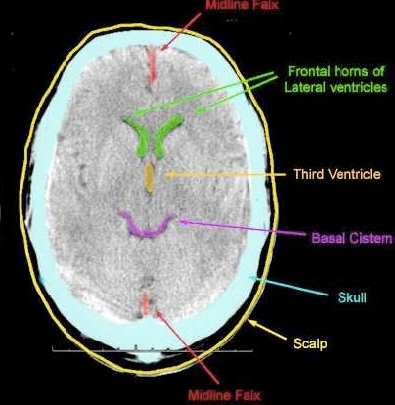
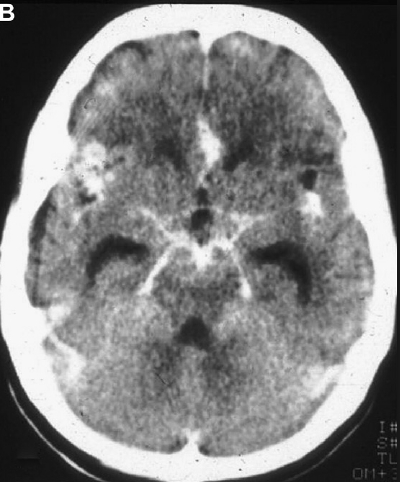
Glioma
pontine glioma
Brain abscess
a condition more commonly seen in patients with cardiac defects that have right-to-left shunts associated with them.
symptoms: he has had a headache and is more lethargic than normal in last 12 hours. On your examination he seems to have a severe headache, nystagmus, and ataxia.,
Botulism
cause: honey
symptoms: and in young children often presents with constipation before the development of the other symptoms listed (facial diplegia and difficulty sucking and swallowing)
CMV vs Toxo
The unscientific, but sometimes useful, way of keeping intracranial calcifications caused by CMV differentiated from those caused by toxoplasmosis is to remember that “CMV” has a V in it, as does “periventricular”; “toxoplasmosis” has an X in it, and the lesions associated with it are scattered throughout the “cortex,” which also has an X in it.
NF vs Tubersous sclerosis
NF: cafe au lait, neurofibromas
TS: ash leaf, angiofibromas
cafe au lait: hyperpigmentation
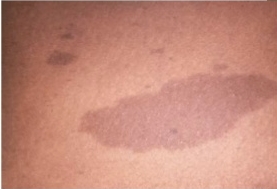
ash leaf: hypopigmentation
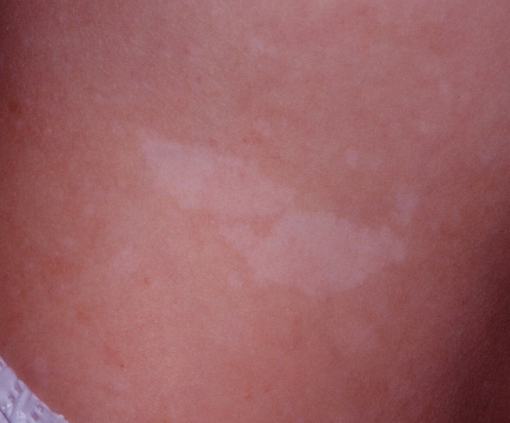
Neurofibromas:
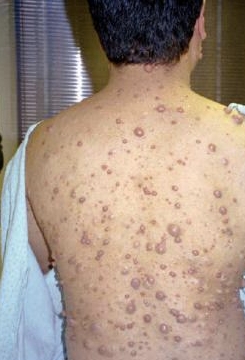
Angriofibromas:
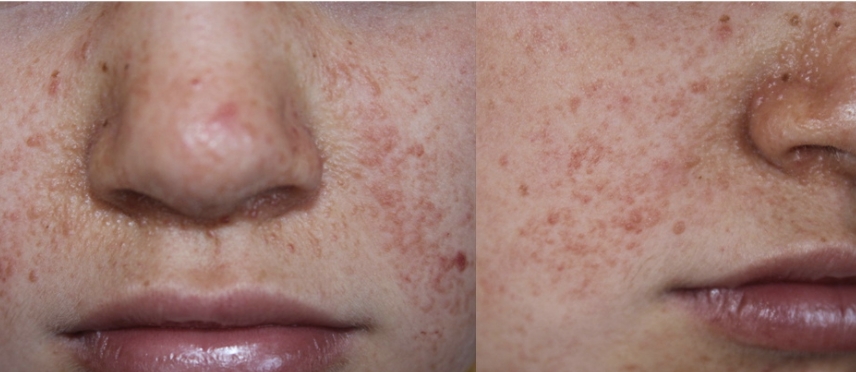
Spinal Muscular Atrophy
aka Werdnig-Hoffman, infantile progressive spinal muscular atrophy.
path: The defect is found in the survivor motor neuron (SMN) gene that stops apoptosis of motor neuroblasts. During development, an excess of motor neuroblasts is noted, and through apoptosis only about half survive in the normal newborn; the SMN gene regulates this natural destruction. A defect in the SMN gene results in a continuation of apoptosis, resulting in progressive destruction of motor neurons in the brain stem and spinal cord.
symptoms: respiratory distress and trouble feeding. On physical examination, you note that aside from shallow respirations and some twitching of the fingers and toes, the infant is not moving, and is very hypotonic. In the mouth there is pooled saliva and you note tongue fasciculations. Deep tendon reflexes are absent. Spinal fluid is normal.
treatment: The only currently available treatment is supportive care.,
prognosis: infants with SMA I usually die of respiratory complications by the second or third year of life.
Three other types of SMA have been described
SMA 0, a rare severe form that is fatal in the perinatal period
SMA II, in which infants may suck normally and despite progressive weakness may survive into the school-aged years
SMA III, which usually presents later and with a better prognosis. Intelligence is normal, and the heart is not affected.
DMD
Increased lordosis, while standing, is evidence of gluteal weakness. Hip waddle gait. Associated features include mental impairment and cardiomyopathy.
Death caused by respiratory failure, heart failure, pneumonia, or
aspiration is common by early adulthood.
Vasovagal
The sequence of events described in the question probably resulted from vasovagal stimulation, often precipitated by pain, fear, excitement, or standing for long periods.
Counseling on proper diet and fluid intake is appropriate; patients should also increase their salt intake. Occasionally patients with recurrent vasovagal syncope may be managed using β-blockers or fludrocortisone.
Tourettes and Tic
symptoms: All have in common the nonrhythmic, spasmodic, involuntary, stereotypical behaviors that involve any muscle group. In this condition, the patient has eye blinking, facial movements, or throat clearing lasting for weeks to about a year.
pt: Transient tic disorder is the most common and is seen more often in boys; a family history is often noted.
treatment: No medications are needed.
Tourette syndrome is a lifelong condition that is characterized by motor and vocal tics, OCD, ADHD. Therapy for the ADDH is helpful, as is medication to control the motor or vocal tics. Multiple psychosocial problems exist with these children; a multidisciplinary approach is helpful
PHACE
phace
McCune Albright
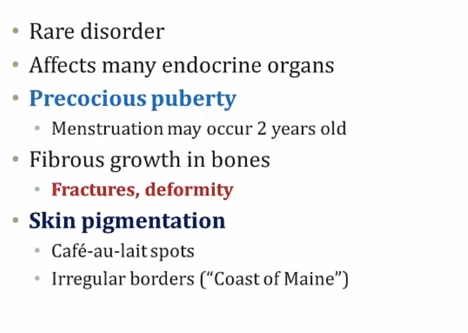
skin (ash leaf), bone (fractures), endocrine (goiter, precocious puberty).,
Last updated
Was this helpful?